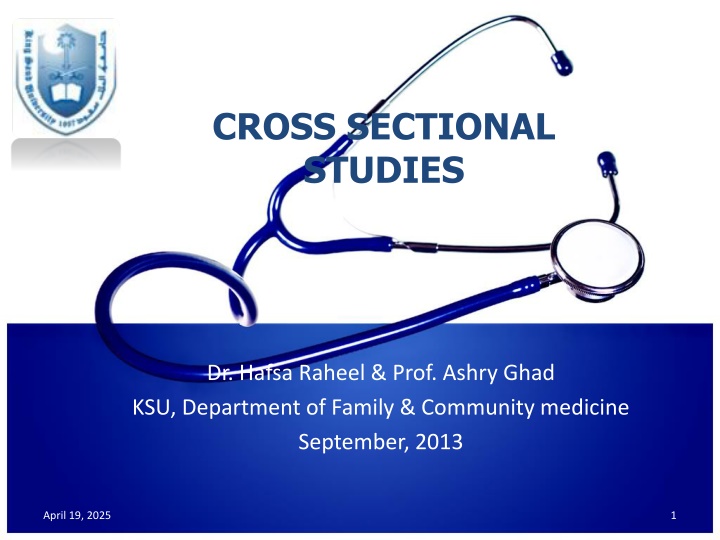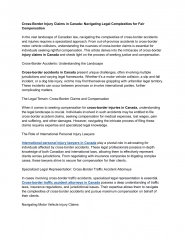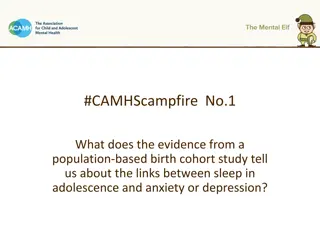
Cross-Sectional Studies in Medicine
Learn about cross-sectional studies in medicine, their objectives, study design, usage in determining prevalence, and how to conduct them effectively. Explore the advantages and disadvantages of this observational design for assessing disease and exposure levels in populations.
Uploaded on | 3 Views
Download Presentation

Please find below an Image/Link to download the presentation.
The content on the website is provided AS IS for your information and personal use only. It may not be sold, licensed, or shared on other websites without obtaining consent from the author. If you encounter any issues during the download, it is possible that the publisher has removed the file from their server.
You are allowed to download the files provided on this website for personal or commercial use, subject to the condition that they are used lawfully. All files are the property of their respective owners.
The content on the website is provided AS IS for your information and personal use only. It may not be sold, licensed, or shared on other websites without obtaining consent from the author.
E N D
Presentation Transcript
CROSS SECTIONAL STUDIES Dr. Hafsa Raheel & Prof. Ashry Ghad KSU, Department of Family & Community medicine September, 2013 April 19, 2025 1
OBJECTIVES OF THE LECTURE OBJECTIVES OF THE LECTURE By the end of this lecture students will be able to: Recognize the concepts & uses of cross sectional studies. Understand the basic features of cross-sectional studies. List the advantages and disadvantages of cross-sectional study design. April 19, 2025 2
Cross-Sectional Studies/ surveys An observational design that measures existing disease (D) and current exposure levels (E) at a single point in time (a cross-section of the population) Exposure and disease status are assessed simultaneously among individuals in a well defined population. time Study only exists at this point in time April 19, 2025 3
Cross sectional studies These are primarily used to determine prevalence, e.g. the number of cases in a population at a given point in time. All the measurements on each person are made once at one point in time. At one point in time the subjects are assessed to determine whether they were exposed to the relevant agent and whether they have the outcome of interest April 19, 2025 4
Study design for cross sectional studies April 19, 2025 5
Cross-sectional Study Sample of Population Physically active Sedentary life style life style Prevalence of IHD Prevalence of IHD Time Frame: Present 6 April 19, 2025
How to run a cross sectional study Formulate the research question(s) and choose the sample population. Then decide what variables of the study population are relevant to the research question. A method for contacting sample subjects must be devised and then implemented. Many cross sectional studies are done using self administered questionnaires or alternatively each of the subjects may be interviewed. In this way the data are collected, summarized in a 2X2 table and can then be analyzed. The principal summary statistic of cross sectional studies is the odds ratio. April 19, 2025 7
How to run a cross sectional study The following table lists the advantages and disadvantages of each: QUESTIONNAIRE (Self-administered ) INTERVIEW Cheap Expensive Low response rate High response rate Large sample size Smaller sample size April 19, 2025 8
Uses of cross sectional studies (Health survey) 1. Describe the state of health Burden of illness: Prevalence &Disability. Burden of mortality: Death 2. Describe the distribution of risk factors & other attributes. April 19, 2025 9
Uses of cross sectional studies (Health survey) 3. Factors associated with diseases e.g. smoking, physical activity. 4. Factors associated with use of health services e.g. awareness of services, health insurance. 5. Determine the association of various factors and diseases. 6. Make comparisons within and among various communities to determine if services are allocated according to needs. April 19, 2025 10
Examples of Cross-sectional Studies 1. National Surveys; National Health and Nutrition Exam Survey (NHANES) in USA 2. Patient satisfaction in primary care clinics 3. CHD in relation to physical exercises. 4. Obesity in relation to diabetes mellitus. 5. Knowledge, Attitude and Practice (KAP) about mammogram, vaccination programs, . 6. A census is another example of a cross sectional study. April 19, 2025 11
Advantages of Cross-sectional Studies Cross sectional studies are the best way to determine prevalence rates; Can estimate overall and specific disease prevalence rates Can estimate exposure proportions/prevalence in the population. They are useful at identifying associations and generating hypotheses about the cause of disease They are useful to study conditions that are relatively frequent with long duration (chronic conditions) April 19, 2025 12
Advantages of Cross-sectional Studies Relatively easy, quick and inexpensive. Because Only one group is used, data are collected only once and multiple outcomes can be studied As there is no follow up, less time and resources are required to run the study. Minimal ethical problems because no intervention is applied. Can be used to estimate the risk by calculating the odds ratio. April 19, 2025 13
Disadvantages of Cross-sectional Studies 1. The most important problem with cross sectional study is that they do not differentiate between cause and effect or the sequence of events; Thus temporal sequence of exposure and effect may be difficult to determine; Chicken-egg dilemma) For example, a study finding an association between low CD4 counts and HIV infection does not demonstrate whether HIV infection lowers CD4 levels or low CD4 levels predispose to HIV infection. April 19, 2025 14
Disadvantages of Cross-sectional Studies 2. Rare conditions cannot efficiently be studied using cross sectional studies because even in large samples there may be no one with the disease. In this situation it is better to study a cross sectional sample of patients who already have the disease (a case series). 3. It deals with survivors so, Not appropriate for studying highly fatal diseases or a disease with short duration of expression 4. Not useful for establishing causal relationships 5. Confounding is difficult to control. April 19, 2025 15
Example Cross-sectional Study * A cross-sectional study of maternal smoking as a risk factor for infant colic. The results of the study are shown below Infant colic No infant colic Total Mother smoking 15 167 182 Mother not smoking 111 2,477 2,588 126 2,644 2,770 * Reijneveld SA, Brugman E, Hirasing RA. Infantile colic: maternal smoking as potential risk factor. Arch Dis Child 2000;83(4):302-303. April 19, 2025 16
Example Cross-sectional Study-cont. Prevalence of colic with smoking mothers = a/(a + b) = 15/182 = 8.2%. Prevalence of colic with nonsmoking mothers = c/(c+ d) = 111/2,588 = 4.3%. Prevalence of colic overall = (a + c)/(a + b + c + d) = 126/2,770 = 4.5%. April 19, 2025 17
References C J Mann. Observational research methods. Research design II: cohort, cross sectional, and case-control studies. Emerg Med J 2003;20:54 60 Hulley SB, Cummings SR, Browner WS, Grady DG, Newman TB. Designing Clinical Research, 3rd Edition 2007 Lippincott Williams & Wilkins 18
Thank You April 19, 2025 19






















